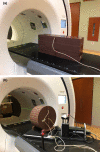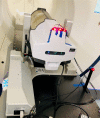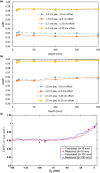Technical Note: Comprehensive performance tests of the first clinical real-time motion tracking and compensation system using MLC and jaws
- PMID: 32277477
- PMCID: PMC7496291
- DOI: 10.1002/mp.14171
Technical Note: Comprehensive performance tests of the first clinical real-time motion tracking and compensation system using MLC and jaws
Abstract
Purpose: To evaluate the performance of the first clinical real-time motion tracking and compensation system using multileaf collimator (MLC) and jaws during helical tomotherapy delivery.
Methods: Appropriate mechanical and dosimetry tests were performed on the first clinical real-time motion tracking system (Synchrony on Radixact, Accuray Inc) recently installed in our institution. kV radiography dose was measured by CTDIw using a pencil chamber. Changes of beam characteristics with jaw offset and MLC leaf shift were evaluated. Various dosimeters and phantoms including A1SL ion chamber (Standard Imaging), Gafchromic EBT3 films (Ashland), TomoPhantom (Med Cal), ArcCheck (Sun Nuclear), Delta4 (ScandiDos), with fiducial or high contrast inserts, placed on two dynamical motion platforms (CIRS dynamic motion-CIRS, Hexamotion-ScandiDos), were used to assess the dosimetric accuracy of the available Synchrony modalities: fiducial tracking with nonrespiratory motion (FNR), fiducial tracking with respiratory modeling (FR), and fiducial free (e.g., lung tumor tracking) with respiratory modeling (FFR). Motion detection accuracy of a tracking target, defined as the difference between the predicted and instructed target positions, was evaluated with the root mean square (RMS). The dose accuracy of motion compensation was evaluated by verifying the dose output constancy and by comparing measured and planned (predicted) three-dimensional (3D) dose distributions based on gamma analysis.
Results: The measured CTDIw for a single radiograph with a 120 kVp and 1.6 mAs protocol was 0.084 mGy, implying a low imaging dose of 8.4 mGy for a typical Synchrony motion tracking fraction with 100 radiographs. The dosimetric effect of the jaw swing or MLC leaf shift was minimal on depth dose (<0.5%) and was <2% on both beam profile width and output for typical motions. The motion detection accuracies, that is, RMS, were 0.84, 1.13, and 0.48 mm for FNR, FR, and FFR, respectively, well within the 1.5 mm recommended tolerance. Dose constancy with Synchrony was found to be within 2%. The gamma passing rates of 3D dose measurements for a variety of Synchrony plans were well within the acceptable level.
Conclusions: The motion tracking and compensation using kV radiography, MLC shifting, and jaw swing during helical tomotherapy delivery was tested to be mechanically and dosimetrically accurate for clinical use.
Keywords: motion tracking; synchrony; tomotherapy.
© 2020 The Authors. Medical Physics published by Wiley Periodicals LLC on behalf of American Association of Physicists in Medicine.
Conflict of interest statement
Both Guang‐Pei Chen and X. Allen Li have received speaker honoraria from Accuray Inc.
Figures









References
-
- Hanley J, Debois MM, Mah D, et al. Deep inspiration breath‐hold technique for lung tumors: the potential value of target immobilization and reduced lung density in dose escalation. Int J Radiat Oncol Biol Phys. 1999;45:603–611. - PubMed
-
- Wulf J, Hädinger U, Oppitz U, Olshausen B, Flentje M. Stereotactic radiotherapy of extracranial targets: CT‐simulation and accuracy of treatment in the stereotactic body frame. Radiother Oncol. 2000;57:225–236. - PubMed
-
- Li XA, Stepaniak C, Gore E. Technical and dosimetric aspects of respiratory gating using a pressure‐sensor motion monitoring system. Med Phys. 2006;33:145–154. - PubMed
-
- Kubo HD, Len PM, Minohara S, Mostafavi H. Breathing‐synchronized radiotherapy program at the university of California Davis cancer center. Med Phys. 2000;27:346–353. - PubMed
MeSH terms
LinkOut - more resources
Full Text Sources

